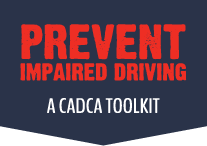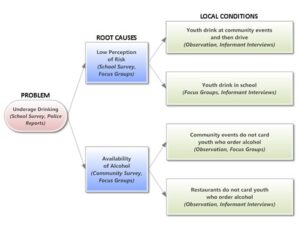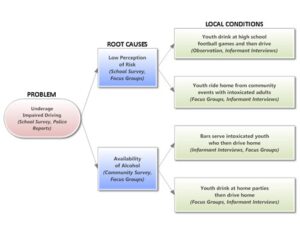Successful Communities
Community Assessment — Data Collection About Impaired Driving
Community Needs Assessment — Data Collection Checklist
This template offers a convenient means for aligning elements of your impaired driving logic model and the population you hope to impact with their indicators and measurements used.
Data and Sources to Collect about Consequences and Problem Statements
1) Fatal and Injury Crash Data – National Highway Traffic Safety Administration) NHTSA: this is generally a more reliable indicator of the level and type of impaired driving in your state and community than arrest data, which is dependent on the level of local law enforcement resources to conduct enforcement campaigns. NHTSA sponsors a data resource website called the Fatal Analysis Reporting System (FARS) that has multiple databases that can be searched at the state and county levels. Go to this web address for the site map.
- CrashStats & NCSA Publications
- National Automotive Sampling System (NASS)
- FARS Encyclopedia
- State Traffic Safety Info
- Traffic Safety Fact Sheets
- Traffic Safety Facts Annual Report
2) Highway Safety and Crash Data – State Highway Safety Offices – You can also search the databases for information from your state offices of highway safety. They may break information by your county/city. If you don’t find what you need online, contact information is provided on each state office website.
To locate your state’s Highway Safety Office, please refer to this site maintained by the Governor’s Highway Safety Association.
3) Cost of Deaths from Crashes – The Centers for Disease Control and Prevention (CDC) have compiled this information by state.
4) Community-Level Crash Data – local law enforcement, fire department/paramedics, hospitals may share information about days, times of day, times of year and location trends for impaired driving crashes.
5) Local Information about Impaired Drivers* – from local police, probation, court or health/treatment
- Numbers of first-time and repeat offenders
- Demographics about first time and multiple offenders: age, gender, ethnicity, census/tract or other residence information (e.g., city, zip code)
* Note that special care is taken to respect compliance with laws that safeguard individual privacy (e.g. HIPAA laws about medical records). Coalitions should receive information aggregated according by the above categories, so that no specific individuals are identified.
Data and Sources to Collect about Root Causes and Local Conditions
1) Number and Density of Licensed Drinking Establishments – your state alcoholic beverage control board or liquor commission can provide information about the number, type and location of establishments that provide beer, wine and/or distilled spirits for consumption on their premises in your community.
The Department of Treasury’s Alcohol and Tobacco Tax and Trade Bureau maintains a list of alcoholic beverage control boards and relevant liquor commissions.
2) Identification of Other Locations Where Drinking/Drug Use Occurs
- Local law enforcement alcohol and drug arrest, incident report and calls for service data
- Key informant interviews
- Focus groups with youth
- Focus groups with neighborhood residents and other adults
3) “Circumstance of Last Use/Drink” self-report surveys – to get further information about settings and circumstances, some law enforcement agencies, DUI/DWI program providers and/or county health offices collect data from people arrested for impaired driving about the last place they drank before driving. Although we know that there is limited accuracy in this kind of self-report, many communities have discovered patterns in the results about locations (licensed alcohol establishments, parks, private parties, etc.) that have helped direct decisions about times and places for sobriety checkpoints, saturation patrols, undercover operations to stop sales to intoxicated patrons and other targeted enforcement efforts.
Read more:
Model Impaired Driving Records Information Systems – Tying Together Data Systems to Manage Impaired Drivers
National Highway Traffic Safety Administration (NHTSA)
Sample Logic Model: Impaired Driving as a Local Condition
Sample Logic Model: Impaired Driving as the Problem
Sample Intervention Maps
Sample Impaired Driving Intervention Map #1
Problem: Alcohol-impaired driving among young adults
Root Cause: Availability of alcohol
Local Condition: Licensed alcohol establishments (restaurants and bars/taverns) are serving alcohol to intoxicated patrons
| Strategy | Intervention |
| Provide Information | Create research briefs that demonstrate the link between over-service of alcohol and community problems such as violence, property crime, and impaired driving injuries/fatalities
Provide information to licensed establishments about the results of surveys of drivers cited for impaired driving who indicate bars/restaurants as their “place of last drink” Create a campaign of visible enforcement against sales to intoxicated patrons: use multiple media outlets to gain the attention of establishment owners, managers, servers and bartenders about fines and other consequences associated with violations |
| Build Skills | Provide training for servers and bartenders about:
Recognizing signs of intoxication Methods for “cutting off” service to intoxicated patrons Serving practices that prevent intoxication |
| Provide Support | Pay overtime for local law enforcement to conduct undercover operations to enforce laws against sales to intoxicated patrons
Pay for law enforcement training about protocols for conducting undercover operations on sales to intoxicated patrons and citing violators |
| Access / Barriers | Offer regular training for licensed establishments in convenient locations and times, and in languages appropriate to the population of servers and bartenders (e.g., Spanish, Mandarin)
Provide training/technical assistance for owners/ managers of licensed establishments to help develop business policies that discourage over-service and provide protocols for employees to follow to handle difficult situations |
| Incentives / Disincentives | Cite and fine servers/bartenders who serve alcohol to intoxicated patrons, as identified through quarterly enforcement operations |
| Physical Design | Provide signage (placards, coasters, etc.) reminding servers and patrons about laws and house policies prohibiting sales to intoxicated patrons |
| Policies or Regulations | Local law enforcement and/or state alcohol licensing board policy, identifying sales to intoxicated persons as a priority target and establishing an annual schedule of enforcement operations to deter the illegal behavior |
Sample Impaired Driving Intervention Map #2
Problem: Underage alcohol-impaired driving
Root Cause: Low perception of harm/consequences
Local Condition: Youth ride home from community events with intoxicated adult drivers who do not get cited.
| Category | Strategy |
| Provide Information |
|
| Build Skill | Provide training for event alcohol servers about:
|
| Provide Support |
|
| Access / Barriers |
|
| Incentives / Disincentives |
|
| Physical Design |
|
| Policies or Regulations |
|



